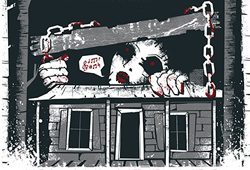
In 2003, a group of Canadian college students at Queen’s University in Ontario decided to reimagine Sam Raimi’s Evil Dead film series into a stage musical as part of their musical theater class. Amazingly enough, the combination of horror and song actually worked, and with the blessing of both Raimi and actor Bruce Campbell, a staged production was held in Toronto later that year.
The success of the performance led to an Off-Broadway run in 2006, as well as an on-going engagement at Planet Hollywood in Las Vegas. More significantly, over 150 different regional theaters around the world have staged performances of Evil Dead: The Musical, making it the twenty-first century equivalent of The Rocky Horror Picture Show.
Writer/director Sam Raimi and veteran actor Bruce Campbell initially filmed Evil Dead as a trilogy, and Evil Dead: The Musical finds a way to incorporate the main plotlines of the first two releases while adding key dialogue from the third as well. The first act, for instance, is primarily based on the original Evil Dead from 1981, while the second act follows the narrative of 1987’s Evil Dead II. Like those films, the main setting for Evil Dead: The Musical is a cabin in the woods containing an ancient book that has the ability to raise an ancient evil.
The third movie in the series, Army of Darkness, takes place in the medieval 1300s, and while not directly part of Evil Dead: The Musical, lead character Ash Williams’ employment at a retail store, classic lines like “This is my Boomstick!” and even the final scene from Army of Darkness are incorporated into the production nonetheless.
In addition to Ash Williams, all the main characters from both Evil Dead and Evil Dead II appear in Evil Dead: The Musical, with the exception of Bobby Joe and Henrietta from the second installment. Some of the characters have been altered – most notably the now dimwitted blond Shelly from the original Evil Dead – while both Annie and Ed from Evil Dead II have been tweaked to give them a more comic persona.
These subtractions and alterations, however, only add to the overall enjoyment of Evil Dead: The Musical, giving the narrative the necessary cohesion to bridge the two films that it is primarily based on. While the Evil Dead from 1981 was a straight-forward horror flick, Evil Dead II often served as a parody of the genre to go along with the horror, and Evil Dead: The Musical has fully embraced the comedic elements of Sam Raimi’s scripts and Bruce Campbell’s performances.
In June 2014, Pittsburgh theater troupe No Name Players brought Evil Dead: The Musical to the Steel City for a three week engagement at Off the Wall Theater in nearby Carnegie. Because of the scope of the special effects needed for the production, No Name Players launched a Kickstarter campaign in April 2014 to raise the necessary funds. The money was put to good use, allowing the theater troupe to enlist local award-winning special effects artist Steve Tolin to help create the overall atmosphere of the performance.
In addition to Tolin, Andrew Hosmer of the Art Institute of Pittsburgh was contracted to fabricate a mounted moose head for the cabin that comes “alive” during the production – as it does within the film Evil Dead II – swinging its head from side-to-side while talking and singing along. It was an amazing piece of special effects, and the official program for the Pittsburgh production of Evil Dead: The Musical listed no less than eight additional designers besides Hosmer who assisted in its construction.
Then there’s the blood splatter. Both Evil Dead and Evil Dead II used buckets of fake blood within their screen frames, and Evil Dead: The Musical is no different. Although the first few rows of Off the Wall Theater were designated as “splash zones,” No Name Players emphasized that no one was immune, going so far as to ask patrons to sign blood splatter wavers and handing out plastic ponchos for them to wear.
Rather than be deterred, audience members embraced this particular aspect of the performance, anticipating the coming onslaught during scenes involving a chainsaw and later when an axe is used to dismember various body parts. Those scenes were paltry, however, compared to the unexpected moments of Act II and the literal blood-bath that arrived as Evil Dead: The Musical reached its climax.
The V Theater at the Planet Hollywood Resort and Casino in Las Vegas has a 450-seat capacity and offers a staggering 100-seat splatter zone for its ongoing performances of Evil Dead: The Musical.
In comparison, the Off the Wall Theater in Carnegie has a 96-seat capacity, but in the hands of director Don DiGiulio and the rest of the No Name Player’s production staff, the cozier space made the Pittsburgh version of Evil Dead: The Musical an equally enjoyable experience – if not more so – than anything the flash and glitter of Vegas could ever conjure.
Anthony Letizia

